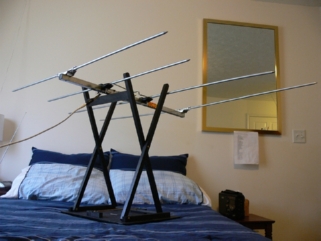

|
|
||||||||||||||||||||||||||||||
|
||||||||||||||||||||||||||||||
|
|
|
|
||
 |
Antenna solution option 1 - temporary antenna
Sometimes it is not
practical to install an external antenna. You can approach this problem
with a pessimistic attitude or be passionate and work around those
limitations. Unless you are living in a concrete underground car park
(I'm kidding) you can still participate successfully in the pursuit of
long distance FM reception! A positive attitude is important, because
frustrations are an inherent feature of this hobby. These are not
limited to: poor conditions, interference, damaged antennas, lack of
free time or fresh allocation of your previously vacant channels to new
stations! By awakening your passion and enthusiasm, you can fight these
limiting factors. A positive, 'can do' attitude helps to ensure the
enjoyment of the hobby is maintained in the long term.
  Temporarily putting an 8 element antenna in your backyard can often work wonders. Use your ingenuity and utilize whatever is available. I have used collapsible wooden chairs, council garbage bins, fibreglass ice boxes, glass and plastic outdoor dining tables. You could even place the antenna vertically and rest it against a fence. The goal here is to raise the antenna off the ground at no cost. Ideally, purchase a telescopic mast with guy wires. Masts are readily available from online retailers including Jaycar and Radio Parts Group. Elevating an antenna may be a crude but simple way to increase gain.
Be
sure to take your temporary antenna inside before storms approach. It
is possible
to setup something as sophisticated and innovative as Andrew,
Felix or Julian
have
achieved. If you need to run the coaxial cabling under a closed door or
window, Jaycar have flat, 20 centimetre long coaxial cables that will
fit. What if you don't
have any outside space at your dwelling? An experiment with a
Matchmaster 3-element FM yagi inside the house was conducted, just out
of curiosity! I operated this antenna connected to a
locally-manufactured Kingray wideband preamplifier operating at maximum
gain. The portable antenna was placed in a room, lying horizontal, one
metre above floor level near a large, double glazed window with
security grilles, approximately 2 x 2 metres square. Outside this large
window, no buildings obstructed the signal path. There was several
square metres of grass
and small garden shrubs. This factor seemed to make a significant
difference. Those same weak signals were not able to be received in
other rooms. There, thick walls and furnishings probably obstructed the weak signals. Interference from nearby
electrical appliances, which had the effect of masking the signals,
exacerbated the problem.
I was surprised how well an indoor antenna performed, relative to my rotatable roof-top horizontal Clipsal 8-element FM yagi. In terms of pure signal-to-noise intelligibility on marginal or weak signals, the external antenna (without preamplifier) outperformed it, but it certainly was not the annihilation I had anticipated. Provided you do not have a lot of localized interference inside your dwelling from electronics or computers and can access a large, unobstructed window, this option may be worth a try. To understand the limitations of propagation within a building, please read this paper by Iulian. In regions such as the United Kingdom and United States, indoor antennas are well elevated. Large, high gain, narrow beam width antennas can be placed in the loft of a dwelling, just below the roof line. For detailed photos, refer to the Photos page, accessible on the menu to the left. Antenna solution option 2 - wideband antenna Ideally, the installation of a roof-top dedicated FM antenna (an antenna only designed for FM band frequencies) is required to adequately receive long distance FM at strong levels. However, under certain circumstances, a high performance VHF or combined VHF/UHF TV antenna may be suitable. The signal strength you receive will be weaker than what would be achieved with a dedicated FM antenna. If you can meet the following 5 conditions, you may be in luck.
Ascertaining the exact specifications and manufacturer of your existing TV antenna will be difficult. It is a gamble, but consider the exercise a fun learning experience! Try the antenna out with your receiver. Carry out a detailed visual inspection of the type, length and number of elements. Note the spacing between elements and the boom length. Draw or photograph the antenna design. Arm yourself with as much detail as possible about the particular design. This will assist in determining whether that particular wideband antenna is adequate for the task of long distance FM reception. Please use this guide to help identify the basic components of an antenna. In my case, the antenna specifications and manufacturer was initially unknown, as it came with the dwelling. In 2007, chances are, it was manufactured by Clipsal, Hills, Matchmaster or Nationwide Antenna Systems (NAS). The antenna turned out to be the NAS 16 Element Combination Antenna for Bands 1-4. This is model #ANTSGL2. This combination antenna has excellent gain, particularly at the high end of the FM band. This antenna outperformed a Dick Smith Electronics’ 4 element FM yagi antenna across the entire FM band.   Unfortunately, in 2010 this wideband antenna was superseded by #ANTSGL2B which is unsuitable as it only covers VHF channels 6-11 and UHF channels 33-50. So, what are good choices if you want to purchase a single, aesthetically-pleasing antenna for both FM and TV? NAS currently offer ‘SignalMAX’ combination antennas suitable for Bands 1-4. Note that Band 2 is FM. These include the 28 Element Premium #ANTSM28, 16 Element Premium #ANTSM16 and 13 Element Premium #ANTSM15. Matchmaster offer suitable models including their #01MM-DB19 & 'Magna Digital' #MD17 and #MD23 antennas. Maximum Gain is quoted to be 4 dB for the FM band (Band 2). The Front-to-back ratio varies between antennas. Please download the domestic live catalogue for the data. Retail price seems to be below the $200 mark. According to the data provided, these combination antennas are suitable for metropolitan areas and some regional areas. The antennas are designed to receive FM as well as VHF/UHF analogue and digital TV signals. Other manufacturers, including Hills also offer combination antennas. Results Both these crude solutions above actually work. These arrangements, using external antennas, will enable satisfactory reception of Cairns FM from Brisbane (1,355 km) when tropospheric weather conditions are optimal, even if the broadcast is being received off the back of a premium wideband antenna. This is not speculation, it is fact. The end result supports the argument proposed earlier. If you are passionate, it is not difficult to achieve satisfactory results, regardless of whether you utilize top-tier receiving antennas or not. Just do it.   Ways to roughly determine your elevation Check Google Maps using the Terrain setting and pay attention to the Elevation Contour lines. Ensure you zoom out first. Alternatively, check Google Maps using the Earth Plug-in. Type in your suburb and postcode into Weather Zone. Beside your latitude and longitude, you will see the elevation in a certain part of your suburb. Try checking the surrounding suburbs if your dwelling lies on a suburb boundary. Plot a short run from your dwelling to another point using Map My Run. You will see the elevation at your property. Comparisons can be made with surrounding suburbs by plotting longer runs. Map My Run is a lot of fun to use, even if you don't run or cycle through your suburb. Obviously, the
elevation of your receiving location is less beneficial to your
reception if a huge mountain exists 1 kilometre away. Unfortunately,
you can tell I
speak from experience! With that in mind, also consider whether there
is line of sight to a particular FM broadcasting site. Potential
physical obstructions can be assessed using Hey What's That. For
detailed links, refer to the Tools page, accessible on the menu to the
left.
|
|
|
|
||
| Site Map |